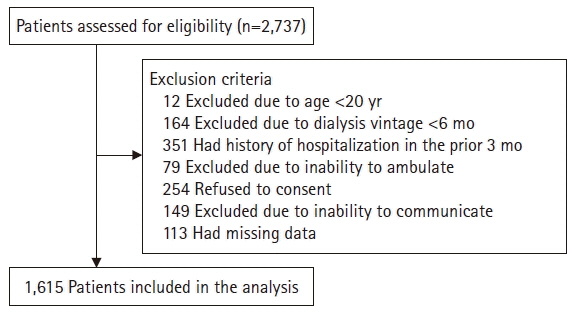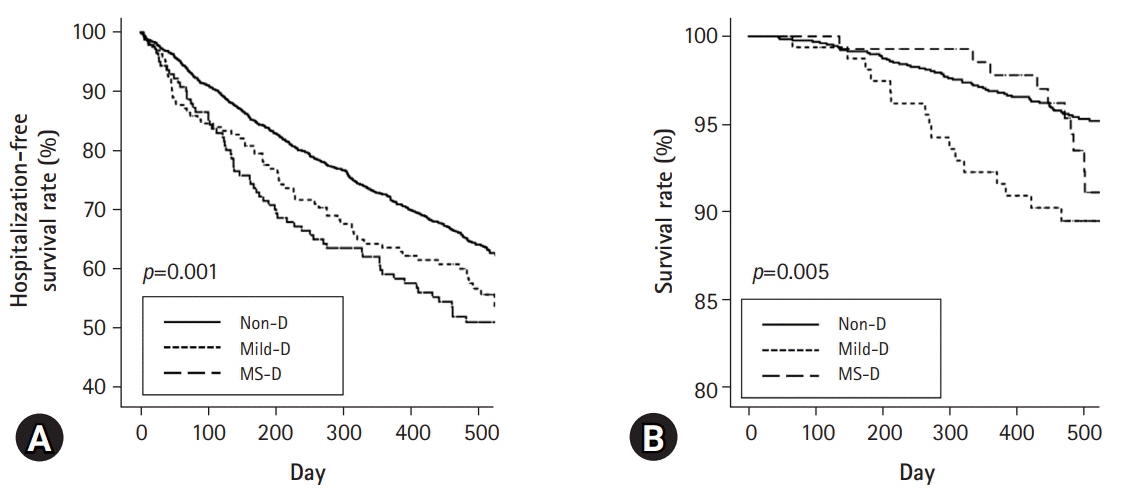Yeungnam Univ J Med.
2021 Apr;38(2):127-135. 10.12701/yujm.2020.00346.
The relationship between disability and clinical outcomes in maintenance dialysis patients
- Affiliations
-
- 1Division of Nephrology, Department of Internal Medicine, Yeungnam University College of Medicine, Daegu, Korea
- 2Division of Nephrology, Department of Internal Medicine, CHA Gumi Medical Center, CHA University, Gumi, Korea
- KMID: 2515186
- DOI: http://doi.org/10.12701/yujm.2020.00346
Abstract
- Background
Dialysis patients are prone to having disabilities. We aimed to evaluate the association between disability and various clinical outcomes in Korean dialysis patients.
Methods
This study consisted of 1,615 dialysis patients from 27 centers. We evaluated disability by using four questions on the activities of daily living (ADLs) concerning whether help was needed for feeding, dressing/undressing, getting in/out of bed, or taking a bath/shower. We divided the patients into three groups: no disability (Non-D, none of the four ADL domains required help; n=1,312), mild disability (Mild-D, one ADL domain required some/full help; n=163), or moderate to severe disability (MS-D, two or more ADL domains required some/full help; n=140). We evaluated falls, frailty, health-related quality of life (HRQoL), mortality, and hospitalization.
Results
The numbers of participants with a fall during the last 1 year were 199 (15.2%), 42 (25.8%), and 44 (31.4%) in the Non-D, Mild-D, and MS-D groups, respectively (p<0.001). The numbers of participants with frailty in the Non-D, Mild-D, and MS-D groups were 381 (29.0%), 84 (51.5%), and 93 (66.4%), respectively (p<0.001). In both univariate and multivariate analyses, the physical component scale and mental component scale scores decreased as the grade of disability increased (p<0.001 for both scores). Hospitalization-free survival rate at 500 days was 64.2%, 56.7%, and 51.1% in the Non-D, Mild-D, and MS-D, respectively (p=0.001 for trend). Patient survival rate at 500 days was 95.3%, 89.5%, and 92.3% in the Non-D, Mild-D, and MS-D, respectively (p=0.005 for trend).
Conclusion
Disability was associated with falls, frailty, HRQoL scales, and survival trends in Korean dialysis patients.
Keyword
Figure
Reference
-
References
1. United States Renal Data System. 2017 USRDS annual data report: epidemiology of kidney disease in the United States. Bethesda (MD): National Institutes of Health, National Institute of Diabetes and Digestive and Kidney Diseases;2017.2. World Health Organization. Disability and health [Internet]. Geneva: World Health Organization;2018. [cited 2017 May 15]. http://www.who.int/mediacentre/factsheets/fs352/en/.3. Jassal SV, Karaboyas A, Comment LA, Bieber BA, Morgenstern H, Sen A, et al. Functional dependence and mortality in the international Dialysis Outcomes and Practice Patterns Study (DOPPS). Am J Kidney Dis. 2016; 67:283–92.
Article4. Yazawa M, Kido R, Ohira S, Hasegawa T, Hanafusa N, Iseki K, et al. Early mortality was highly and strongly associated with functional status in incident Japanese hemodialysis patients: a cohort study of the large national dialysis registry. PLoS One. 2016; 11:e0156951.
Article5. Lee SY, Yang DH, Hwang E, Kang SH, Park SH, Kim TW, et al. The prevalence, association, and clinical outcomes of frailty in maintenance dialysis patients. J Ren Nutr. 2017; 27:106–12.
Article6. Woods NF, LaCroix AZ, Gray SL, Aragaki A, Cochrane BB, Brunner RL, et al. Frailty: emergence and consequences in women aged 65 and older in the Women’s Health Initiative Observational Study. J Am Geriatr Soc. 2005; 53:1321–30.
Article7. Buchner DM, Hornbrook MC, Kutner NG, Tinetti ME, Ory MG, Mulrow CD, et al. Development of the common data base for the FICSIT trials. J Am Geriatr Soc. 1993; 41:297–308.
Article8. World Health Organization. Physical activity [Internet]. Geneva: World Health Organization;2018. [cited 2017 May 15]. http://www.who.int/mediacentre/factsheets/fs385/en/.9. Johansen KL, Chertow GM, Jin C, Kutner NG. Significance of frailty among dialysis patients. J Am Soc Nephrol. 2007; 18:2960–7.
Article10. Park HJ, Kim S, Yong JS, Han SS, Yang DH, Meguro M, et al. Reliability and validity of the Korean version of Kidney Disease Quality of Life instrument (KDQOL-SF). Tohoku J Exp Med. 2007; 211:321–9.11. Ware JE Jr, Sherbourne CD. The MOS 36-item short-form health survey (SF-36). I. Conceptual framework and item selection. Med Care. 1992; 30:473–83.12. McDermott S, Turk MA. The myth and reality of disability prevalence: measuring disability for research and service. Disabil Health J. 2011; 4:1–5.
Article13. Katz S, Ford AB, Moskowitz RW, Jackson BA, Jaffe MW. Studies of illness in the aged. The index of ADL: a standardized measure of biological and psychosocial function. JAMA. 1963; 185:914–9.14. LaPlante MP. The classic measure of disability in activities of daily living is biased by age but an expanded IADL/ADL measure is not. J Gerontol B Psychol Sci Soc Sci. 2010; 65:720–32.
Article15. Katz S, Downs TD, Cash HR, Grotz RC. Progress in development of the index of ADL. Gerontologist. 1970; 10:20–30.
Article16. Cole SR, Kawachi I, Sesso HD, Paffenbarger RS, Lee IM. Sense of exhaustion and coronary heart disease among college alumni. Am J Cardiol. 1999; 84:1401–5.17. Sy J, Johansen KL. The impact of frailty on outcomes in dialysis. Curr Opin Nephrol Hypertens. 2017; 26:537–42.
Article18. El-Khoury F, Cassou B, Charles MA, Dargent-Molina P. The effect of fall prevention exercise programmes on fall induced injuries in community dwelling older adults: systematic review and meta-analysis of randomised controlled trials. BMJ. 2013; 347:f6234.19. Desai M, Mohamed A, Davenport A. A pilot study investigating the effect of pedalling exercise during dialysis on 6-min walking test and hand grip and pinch strength. Int J Artif Organs. 2019; 42:161–6.
Article20. Cho JH, Lee JY, Lee S, Park H, Choi SW, Kim JC. Effect of intradialytic exercise on daily physical activity and sleep quality in maintenance hemodialysis patients. Int Urol Nephrol. 2018; 50:745–54.
Article21. Lorenz EC, Hickson LJ, Weatherly RM, Thompson KL, Walker HA, Rasmussen JM, et al. Protocolized exercise improves frailty parameters and lower extremity impairment: a promising prehabilitation strategy for kidney transplant candidates. Clin Transplant. 2020; 34:e14017.
Article22. McAdams-Demarco MA, Law A, Garonzik-Wang JM, Gimenez L, Jaar BG, Walston JD, et al. Activity of daily living disability and dialysis mortality: better prediction using metrics of aging. J Am Geriatr Soc. 2012; 60:1981–2.
Article23. Ng TP, Feng L, Nyunt MS, Feng L, Niti M, Tan BY, et al. Nutritional, physical, cognitive, and combination interventions and frailty reversal among older adults: a randomized controlled trial. Am J Med. 2015; 128:1225–36.
Article24. Ng TP, Nyunt MS, Feng L, Feng L, Niti M, Tan BY, et al. Multi-domains lifestyle interventions reduces depressive symptoms among frail and pre-frail older persons: randomized controlled trial. J Nutr Health Aging. 2017; 21:918–26.
Article25. Son KY, Kim SH, Sunwoo S, Lee JY, Lim S, Kim YS. Association between disability and cardiovascular event and mortality: a nationwide representative longitudinal study in Korea. PLoS One. 2020; 15:e0236665.
Article26. Park JM, Oh U, Roh BR, Moon Y. Disparities in mortality by disability: an 11-year follow-up study of 1 million individuals. Int J Public Health. 2017; 62:989–96.
Article27. Kang SH, Do JY, Lee SY, Kim JC. Effect of dialysis modality on frailty phenotype, disability, and health-related quality of life in maintenance dialysis patients. PLoS One. 2017; 12:e0176814.
Article28. Tufan F, Topcu Y, Bahat G, Kara MA. Limitations of the continence item in Katz Activities of Daily Living scale. Gerontol Geriatr Res. 2016; 2:1008.
- Full Text Links
- Actions
-
Cited
- CITED
-
- Close
- Share
- Similar articles
-
- Which blood pressure metrics should be used in patients on dialysis?
- Relationship between Cognitive Impairment and Depression in Dialysis Patients
- Relatioship between Dialysis Adequacy and Anemia in Patients with Hemodialysis
- Subjective Global Assessment of Nutrition in Maintenance Hemodialysis Patients
- Pathogenesis and Treatment of Dyskalemia in Maintenance Hemodialysis and CAPD



